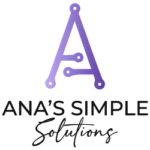Simplify Goal Management with Airtable Goal Tracking
Are you someone who struggles to keep track of your goals? Do you find it hard to manage them effectively and efficiently? I’d like to encourage you to try a little tool called “Airtable” to help you start to organize your goals (and whatever else you need in your life.) Whether you are a small business owner or an individual looking to organize your personal goals, Airtable has got you covered.
In this blog post, we will explore everything you need to know about using Airtable for goal management. We’ll walk you through the basics of the platform, how it structures your goals and projects just like lego blocks, and how you can apply your SMART goals in Airtable. We will also share tips on optimizing the platform for your specific business needs. In addition, you’ll find an Airtable template to use as a starting point for organizing and tracking your goals.
Alrighty then, let’s go!
Understanding Airtable for Goal Management
Airtable can uplevel your goal management (once you have set your goals… check out my blog on how to do that here! ) with its user-friendly interface, empowering you to track and prioritize your goals effortlessly. By centralizing all your goals in one place, Airtable provides a streamlined experience that shows and connects to other areas of your business, making gathering metrics and tracking the projects much simpler than going 10 places to find information.
Airtable has a lot of free templates that will allow you to create a goal and/or management system tailored to your specific needs – (or you could check out my super low-priced one! -> Airtable goal tracker.)
Additionally, the features like linking and filtering, Airtable enables efficient organization and visualization of your goals, helping you and your team stay focused and motivated. Streamline your goal management process with Airtable and unlock your full potential.
How Does Airtable Support Business Goals?
Airtable is a powerful database tool that supports businesses in all levels, but started with the small business in mind.
It is a collaborative platform for teams to align their objectives and track key metrics throughout their organization (as well as many other aspects). With integrations and flexibility, Airtable enables seamless data sharing and allows businesses to not only manage, but also share it’s goal management system with other tools for easy communication.
Pretty cool yes?
Applying SMART Goals in Airtable
Once you have figured out what your new goals are, you are ready to set them up in Airtable.
I have created a previous blog about how to specifically do this that is applicable in this situation.
This will make it extremely easy to end up setting up your project management tool or do your management with Airtable if you prefer.
In my goal-tracker, I have a Form that can be filled out to set my goals and make sure that they are SMART goals for my business.

This will automatically add it to my Goal Spreadsheet and tell me HOW these will be measured throughout the quarter of year.
The first step, DONE, getting them in Airtable.
The next part of this is figuring out the steps that need to be taken in order to help the goal be successful.
This is the starting point of your internal projects that are related to each goal.
From the list of steps, create 1 project for each major step. This is best done to be listed on another tab and associated to the goal that it goes to. You can do this by adding a project on the project tab, or clicking the “+” sign.

These are the building blocks of reaching your goals.
Some of them will be one-time tasks
Some of them will be creating a system or a repeating series of tasks that need to be done weekly
In either case, it is these “Projects” or “Tasks” that will determine the measurement of your goal-reaching.
Airtable Goal Tracking
At this point in the process, I recommend that you either put the projects and the tasks inside of a project management tool or use AT as a PM tool for these goals specifically. But the actual TRACKING of the goals I recommend to be in an Airtable Base.
Reason being, this program was MADE to handle data and information and combine it with other information, making it easier to pull in information automatically as your business grows. It really is it’s superpower.
To make sure that the information is being updated, just make sure that there is a reminder to yourself, or your team, in your PM tool to update the metrics 1x a week.
As you learn more and use Airtable more, you will be able to automate these metrics in their appropriate spots.
Important Note:
ONE of the Projects that you need to include in EACH of these is to make sure to track your goals at least 1x a week and update when necessary. I find actually creating a daily/weekly to-do list that needs to be done every day is the best way to create this habit. This can be done in ANY tool as long as it’s someplace that you will make sure to check.
In my goal-tracker, I have added a Metrics tab, where we can account for all of the targets and actuals.
What Makes Airtable a Preferred Choice for Small Business Owners?
Because this software is so flexible and pliable, it is a well-known software choice for the companies that have specific information and project management needs. It stands out as a preferred choice for small business owners due to its user-friendly interface and customizable goal management system.
In the end, finding software that can grow with you, that is the best in its class and is affordable is a definite plus of this tool. I encourage you to see if it’s something that you could use in your business.
In conclusion, Airtable Goal Tracking is highly recommended if you haven’t been using anything else or if you haven’t found a good way to make your goals front of mind.
The software’s versatility and customizable features make it a preferred choice for small business owners looking to optimize their goal management strategies.
Ready to simplify your goal management? Download Airtable now and take control of your business’s success.
Want to read more?
Looking to learn more?
Check out these blogs:
Simple Task and Project Management 👈
Planning your Week and Calendar Scheduling 👈
How to focus on the right things 👈



